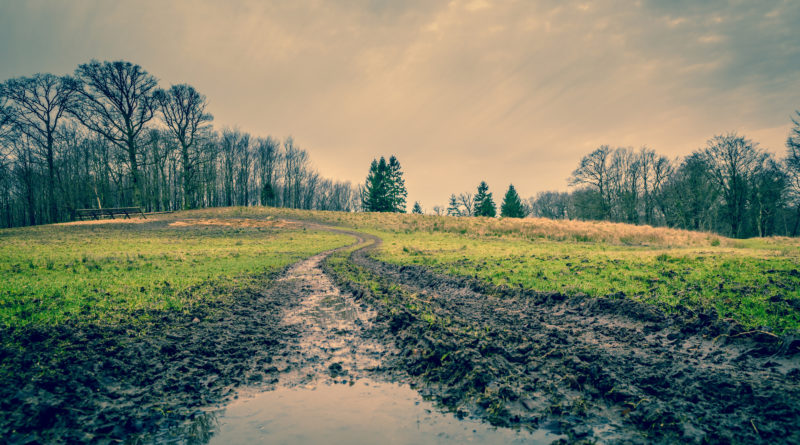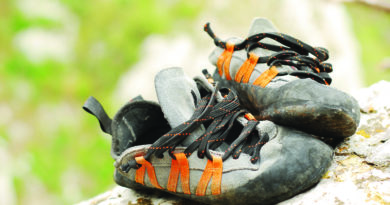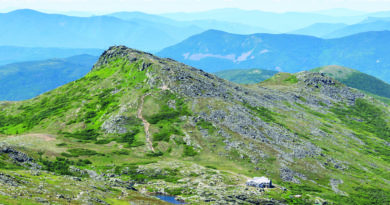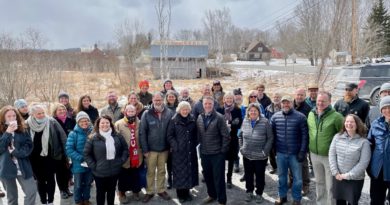Reasons to Love Mud Season
B
egin with a definition. Mud season is a phenomenon of northern climes; a transition from brittle winter to soft spring; a period characterized by snow melting in the mountains, rain falling across the valleys, and ground that has been frozen solid for six months finally (albeit slowly) thawing out. The thaw proceeds top to bottom, exposed surface to hidden depths, which means an impervious horizon of ice-fused soil—a plate, basically, a pan—underlies the newly liquified upperworld for a number of weeks. This in turn means oversaturation, runoff with nowhere to run—copious mud, voluminous mud, catastrophic mud that can, on occasion, recall the artist Hokusai’s famous woodblock print of a curling, boat-dwarfing ocean wave.
Accurate enough. But besides the nod to Hokusai, that’s a rather technical approach to understanding a non-technical, not-in-the-dictionary, widespread colloquialism. Mud season, also referred to as “the fifth season,” is less rigorous science than messy culture. Accordingly, it asks for a sweeping survey, a wide-ranging appraisal.
Crack a beer on an aimless Friday night—click—and enter an internet search for “mud.”
Here are F-350s mired to their axles, sedans sunk to their bumpers. Here are peanut butter roads chewed, swallowed, and spit out by some road-masticating, road-regurgitating giant. Here are boots of all imaginable makes and models, clogged culverts, 20-degree nights and 55-degree days, tentative daffodils. And here, too, are words heaped atop words, so many garden blogs and tourism blogs and gear blogs and, oh mercy, my achy laptop eyes!
“Isn’t very appealing,” the bloggers blather. “Grunts of frustration,” note the home-bound mountain bikers and trail hikers. Dogs are invoked—their dirty paws, the need to constantly towel off shaggy, dragging, dripping bellies—and for every happily-befouled canine there’s a corollary gripe about stained carpets. “Difficult,” the blatherers persist. “Miserable.” One particularly enthusiastic lady from Vermont goes so far as to drop “evil” into the mix.
Granted, mud season is by her account a “necessary” evil, but still. Evil? That’s preposterous. Come along with me, dear reader, and I’ll show you a different version of the slop.
Take the Champlain Valley, on a random Tuesday afternoon. The sky a low gray ceiling, a sagging tent of clouds held aloft by skeletal hardwoods. We suit up in the shabbiest jeans, shabbiest flannel shirt, shabbiest wool cap, and hopscotch the puddled driveway, aiming for a marshy, nondescript creek that hides in a crease beyond fields of stubble corn. Damp bramble hedge (duck and weave). Rusty barbed wire fence (depress and step). Staggering, stumbling, filthy from toes to waist, we tingle with the recognition that this excursion requires no automobile, no money, no phone, no fuss. The fields are lumpy and juicy, patched yellow with last autumn’s dying and green with vernal growth. The fields are gentle, untouched by wind. At last, creekside, we settle the denim to a mossy log and gaze into the crosshatched mystery of broken reeds, bent rushes, tattered cattails.
Honking geese. Happiness. Not ecstasy, not pumped, jazzed, or gonzo—just plain, mundane, quasi-boring happiness. Gray-sky happiness. Muddy-margin-of-the-season happiness. Happiness that is solemn, almost sad.
I was raised in Vermont’s mud, yes, but I was also raised by Vemont’s mud (insofar as places, like good parents, provide children with opportunities to explore and experiment and expand). Thus, my affinity for the fifth season is familial, cozy. Life commences with primordial ooze. Fecund glop is the prima materia. I crawled from the womb of mother mud at the dawn of creation and will eventually, inevitably, return to the sweet suffocating embrace of my muddy father. Feeling this in my blood and bones—feeling it there by the mellow, melancholy creek beyond the bland, beautiful fields—I have to scratch my chin and wonder: Why the disparagement? Why the blogosphere’s perverse yearning for spick-and-span muddlessness?
A partial answer goes as follows: hobbies and pastimes; action sports; chasing the gnar and pursuing the stoke; this insane, egoistic, regrettably prevalent notion that nature is a playground, a Disneyland established and maintained so that we can get an adrenaline buzz, get an Instagram photo, get exercise, get our rocks off however we idiosyncratically please without being inconvenienced by “crappy conditions.”
During the limbo of mud season, hiking and biking trails are closed (a principle of Leave No Trace is to travel on durable surfaces), and the rural byways that could, theoretically, lead to some great new sexy adventure are, well, talk to that road-chomping giant, that elemental monster with peanut butter dripping down his chin. Furthermore, the weather is erratic, sleety then rainbowed, blustery then calm, and this meteorological iffyness tends to kibosh weekend plans.
In sum, mud season rejects anthropocentrism and its (dystopian) fantasy of a world at our beck and call, a world responsive to our scheduling needs, a world tailored to nonstop easy enjoyment. For this reason, people dislike it. For this reason, I love it.
There are other reasons, of course. I love it because of raccoon prints. I love it because of invigorated waterfalls. I love it because of drizzled-upon Holsteins, their glittery eyelashes. I love it because the kitchen’s Crockpot bubbles cheerily when I return home. I love it because the heavy, tread-clotting, thick and sticky mud slows me down, both physically (strolling the stubble fields) and mentally (schemes, dreams, aspirations, ambitions).
Evil? Mud season? As Shakespeare quipped, sounding exceedingly Zen: “There is nothing either good or bad, but thinking makes it so.” My thinking makes mud season a gateway, a portal to the intricate, textured, moody, dynamic earth; the nearby earth of budding plants and squawking nestlings and flowing muck; the ever-present earth that we frequently miss in our headlong rush toward excitement elsewhere.
We’ll get to hiking and biking and all the rest in due time, I promise.
Leath Tonino is a native of the Champlain Basin and the author of two essay collections about the outdoors, most recently The West Will Swallow You (Trinity University Press). A different version of this essay appeared in Adventure Journal Quarterly.




